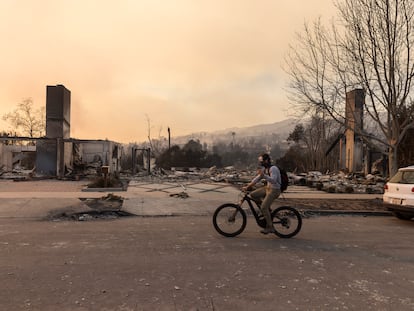A journey to the devastation of Sunset Boulevard, L.A.’s iconic artery
The last six miles of the 23.6-mile long iconic boulevard have been consumed by one of the worst fires in the city’s history. We traveled down that stretch to survey the damage and talk to residents
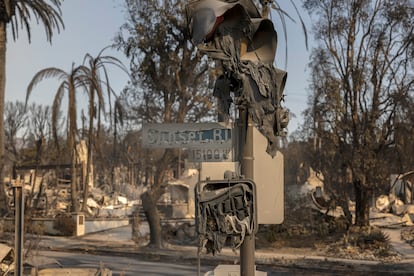
Sunset is the beating heart of Los Angeles, the street that is photographed by tourists and desired by businesses. It extends along 23.6 miles (38 kilometers) and has 17,383 door numbers. There are palm trees everywhere, grandiose mansions and decadent apartments, pricey restaurants and simple hamburger joints, luxury stores and street markets; also to be found there is part of Beverly Hills and the University of California.
Sunset Boulevard is steeped in more than 200 years of history, from its origin as a route to take cattle down to the sea to its most recent and painful episode: the wildfires that have ripped through 40,000 acres of L.A. county and driven 150,000 people from their homes, leaving 24 dead and dozens missing. The worst of these fires, in the Pacific Palisades, originated to the north and has ravaged everything in its path in the last six miles of the boulevard. Its scenic landscape is now awash with ash.
Partially closed to the public, locals watch the fate of Sunset from a distance — all except the residents of Pacific Palisades, the neighborhood that occupies the final stretch and has been hardest hit, with 24,000 acres burned and thousands evacuated since the fires started on January 7.
With their homes razed, residents are trying to return to see what, if anything, is still standing. The Londoner David has lived in the neighborhood for more than 15 years, in a house he knows no longer exists. “But I want to go see it, it’s a kind of catharsis, I need it,” he says, with his little dog Betty sitting by his side in a car that has been stuck in a line for almost two hours to get past the security barriers. In those last six miles, the road is cut off at three checkpoints, allowing only emergency services, the press and a controlled number of residents through. Technically, residents can only go in for medicines, but many ask journalists to get them in on the sly.
Up to number 13,000 Sunset Blvd, in the exclusive Brentwood neighborhood, everything seems normal. A couple of miles further on, entering the Pacific Palisades area, at about number 14,500, an unrecognizable landscape emerges, akin to a war zone. The cars are shells. The houses still standing seem like miracles. A few meters ahead is the epicenter of the catastrophe, and Fire Station Number 69, which failed to contain the flames in its area. However, the blaze barely touched its stronger structure, nor that of the Corpus Christi parish, a few feet ahead: made of iron and brick, its exterior survives.
As the main building material in the United States is wood, it hasn’t taken much for homes to go up in smoke. Barely a few chimneys and walls are left standing, and not many street signs or traffic lights, which appear to have melted. By January 10, the authorities were already checking the street lighting, the water supply and the power and gas systems; Southern California Gas was quick to shut off the main supply in the area, and was also cutting it off house by house as a precaution. There are nearly 13,000 structures affected by the fire throughout the city.
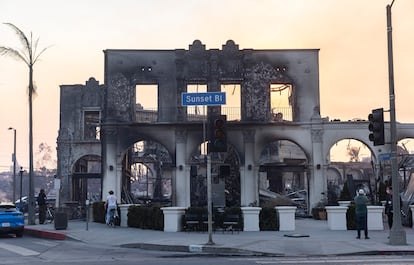
Winds of up to 100 mph have fueled the misfortunes of this torn city. Every Southern Californian knows them as the Santa Ana winds, a phenomenon that blows in from the northeast of the state, between the mountainous canyons towards the Pacific, drying everything in their path. The authors Raymond Chandler and Joan Didion have described their destructive power. In 1957, these winds blew for three or four days, causing a fire that scorched 10,000 acres in the San Gabriel Mountains. “For people who don’t live in Los Angeles, it’s hard to realize how the Santa Anas shape the local imagination. The burning city is Los Angeles’ most profound image of itself,” Didion wrote in 1969.
This time, a lack of rain and humidity exacerbated the hurricane-force winds which blew embers for miles, spreading the fires at an unprecedented rate. The strength of the wind meant that firefighting helicopters and aircraft were unable to operate just when they were most needed.
The Village, at 15,000 Sunset, has been left standing like a souvenir of the exclusive Pacific Palisades. The open-air mall, with its fast-food restaurants, upscale supermarkets and designer boutiques, has been left largely intact. Despite this, its owner and developer, the billionaire Rick Caruso, was the first voice to slam the authorities’ response to the emergency. “There is no water in the Palisades. It’s not coming out of the hydrants. This is totally a mishandling on the part of the city. It’s not the fault of the firefighters, it’s the fault of City Hall,” said Caruso, who lost the 2022 mayoral election as a Republican candidate.
Caruso’ words were echoed by the conservative press and have shaped the political battle. Authorities have claimed that the hydrant problem stemmed from the extremely high demand for water, which quadrupled on January 7 across the county, servicing 10 million people and fires raging non-stop. This caused a huge drop in water pressure for 15 hours. In addition, a huge tank holding 442 million liters of water near Palisades was empty because of repairs that began nearly a year ago. Caruso’s allegations have forced California Governor Gavin Newsom to call for an investigation.
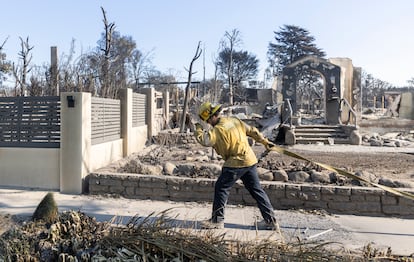
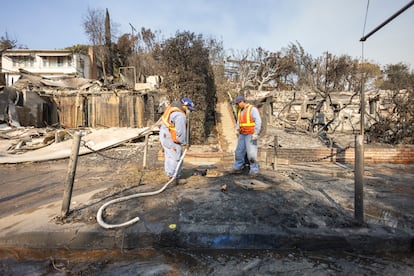
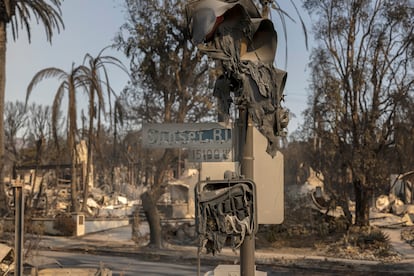
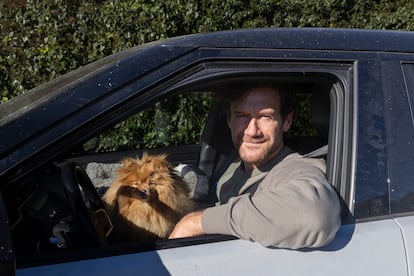
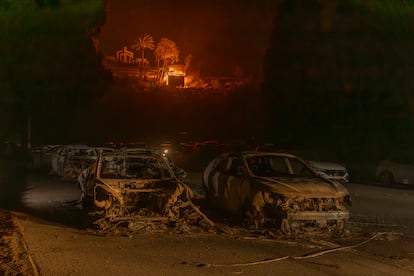
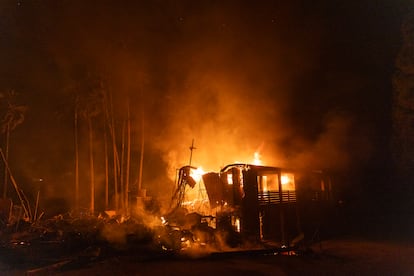
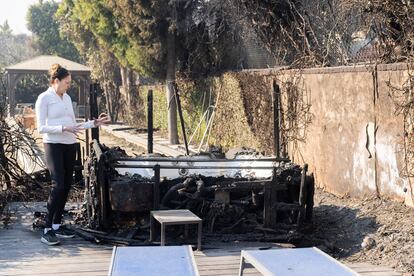
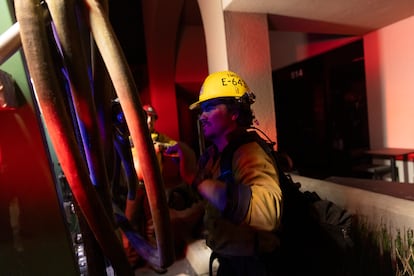
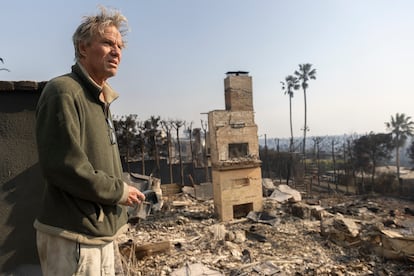
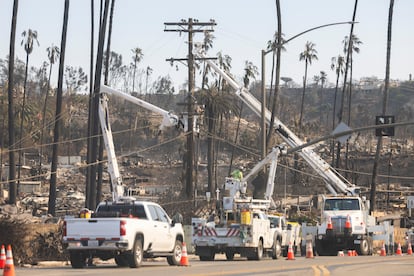
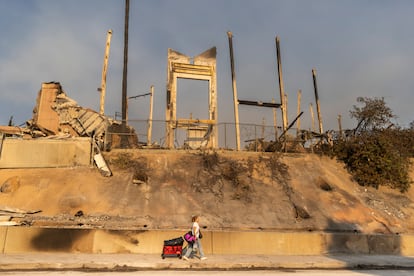
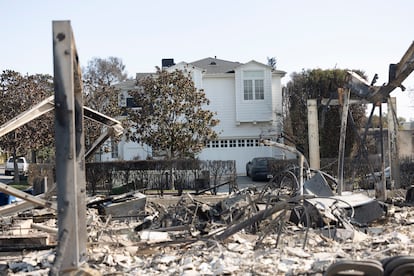
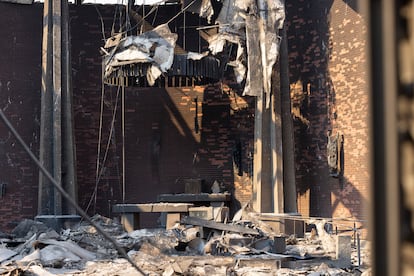
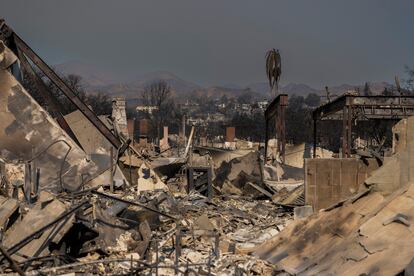
State authorities have prohibited insurers from cancelling or not renewing policies for residents in the disaster zone. The actors Laura Lenée and Regan Patno say they trust their insurance company; they have no choice, she says. Their home has been spared: it’s on Marquez Terrace, a couple of blocks above Sunset. Lenée, also a former model, asks for shoes to be removed to enter her house, though she later realizes that ash, dust and mud from the outside have invaded the place. Patno has gone out to inspect the neighbors’ houses and can’t stop marveling at how the one above his has burned to the ground, while they themselves have only had some backyard furniture scorched and, yes, the jacuzzi has gone. “They had a great car...”, he says in amazement. He is in love with the neighborhood, like so many other locals: “It’s quiet, close to the beach, with good schools, and if you live on a cul-de-sac, like me, even better,” he says.
The Palisades started out as a middle-class neighborhood. Founded in the 1920s, it was populated by European exiles from World War II, and was also a favorite haunt of some of Hollywood’s earliest celebrities. At 14,000 Sunset, there was Will Rogers, one of the industry’s highest-paid actors in the 1930s, an influential commentator and humorist on national politics, and perhaps the first figure to inspire American talk show hosts. His widow donated the 145-acre property to the state in 1944. It became a popular public park for sports and hiking. His imposing mansion remained on the site, also made of wood, with 31 rooms, stables, a polo field and a golf course.

All that is gone now. On January 9, two California landmark public employees stuffed what little the fire had spared into cardboard boxes. “Fortunately, we were able to get most of the collection out in time,” said one. “The thousands of political cartoons and several of the artifacts are safe.” The horses that inhabited the property were also evacuated and are alive and well.
Rogers was hardly the only celebrity who made this area his home. Adam Brody and Leighton Meester are among those who have lost their homes, along with Sir Anthony Hopkins and Mexican actress Karla Souza. Tom Hanks’ mansion was narrowly saved, as was that of James Woods, who posted images of the flames reaching his terrace.
The real estate website Zillow indicates that the average price of homes in Pacific Palisades is $3.5 million compared to the city average of $950,000, which makes it one of the most expensive neighborhoods in Los Angeles. The luxury clothing, mattress and flower stores in the neighborhood’s commercial area, between Sunset and Via de la Paz, attest to this, although not all of them are still standing: some of its restaurants, its Starbucks and a couple of banks have disappeared. As in every catastrophe, they will be rebuilt; and as in every catastrophe, speculation and prices will soar.

Following the gentle curves of Sunset Boulevard, you finally reach the last of its 17,000 numbers, and the Pacific Ocean. By the beach the sirens can still be heard. The usually overcrowded parking lot now holds just a few authorized cars and fire trucks that come to rest and get an internet signal. But there are also some green vans indicating that the capitalist spirit is alive and well.
These are self-styled “service and recovery” companies, which are poised for action. They are contracted by insurance companies or individuals to provide services: when a fire breaks out, the priority is usually to “recover elementary things such as documents”, pets or objects, explains the manager, Tony Cisneros. After the initial panic, they carry out a cleaning service, restoration, removals....
“We are an intermediary that helps with the process,” Cisneros says. “We provide services but we also know how to respond in case of emergency, and we have batteries, water... we have electric generators and we can protect a house from looting,” he says. Looting has been one of the main concerns of the evacuees: 20 people have been arrested so far, and the city has decided to establish a curfew in fire-ravaged areas to prevent it.
Like Sunset, Los Angeles is a city of contrasts. It has 45,000 homeless people while the majority of its population are middle-class workers, and then there are the uber-rich who boast Picassos in their living rooms. Some are so rich that they made calls to hire private firemen, which triggered popular indignation. But to no avail. Not even the five or six million mansions that stood on Sunset could be saved, nor their churches and cafes. On Sunset, there was little to be done no matter what the bank balance of the victims.
Sign up for our weekly newsletter to get more English-language news coverage from EL PAÍS USA Edition
Tu suscripción se está usando en otro dispositivo
¿Quieres añadir otro usuario a tu suscripción?
Si continúas leyendo en este dispositivo, no se podrá leer en el otro.
FlechaTu suscripción se está usando en otro dispositivo y solo puedes acceder a EL PAÍS desde un dispositivo a la vez.
Si quieres compartir tu cuenta, cambia tu suscripción a la modalidad Premium, así podrás añadir otro usuario. Cada uno accederá con su propia cuenta de email, lo que os permitirá personalizar vuestra experiencia en EL PAÍS.
¿Tienes una suscripción de empresa? Accede aquí para contratar más cuentas.
En el caso de no saber quién está usando tu cuenta, te recomendamos cambiar tu contraseña aquí.
Si decides continuar compartiendo tu cuenta, este mensaje se mostrará en tu dispositivo y en el de la otra persona que está usando tu cuenta de forma indefinida, afectando a tu experiencia de lectura. Puedes consultar aquí los términos y condiciones de la suscripción digital.
More information
Archived In
Últimas noticias
Most viewed
- Reinhard Genzel, Nobel laureate in physics: ‘One-minute videos will never give you the truth’
- Oona Chaplin: ‘I told James Cameron that I was living in a treehouse and starting a permaculture project with a friend’
- Pablo Escobar’s hippos: A serious environmental problem, 40 years on
- Charles Dubouloz, mountaineering star, retires at 36 with a farewell tour inspired by Walter Bonatti
- Why we lost the habit of sleeping in two segments and how that changed our sense of time

